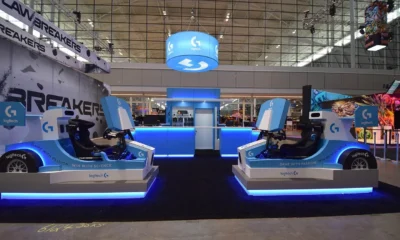Technology
Random Year Generator: Your Complete Guide to Date Randomization

Introduction
Have you ever needed to generate random years for testing, research, or creative projects? A random year generator is a specialized tool that produces unpredictable year values within specified ranges, serving countless applications across various fields. From software testing and historical research to game development and statistical analysis, these tools provide the randomized temporal data that modern projects demand.
Random year generators eliminate the bias that comes with manually selecting dates, ensuring true randomization for your data sets. They’re particularly valuable when you need to create realistic test scenarios, populate databases with diverse temporal information, or conduct research that requires unbiased year selection.
This comprehensive guide will walk you through everything you need to know about random year generators, from their technical foundations to practical applications across different industries.
How Random Year Generators Work
Random year generators operate on algorithmic principles that produce pseudo-random numbers within specified year ranges. Most generators use mathematical formulas called pseudo-random number generators (PRNGs), which create sequences of numbers that appear random but are actually determined by initial seed values.
The Technical Foundation
The core mechanism involves several key components:
Seed Values: These initial numbers determine the starting point for the random sequence. Many generators use system timestamps or user-provided seeds to ensure different results each time.
Range Parameters: Users typically specify minimum and maximum year values, such as 1900-2024 or any custom range that suits their needs.
Distribution Methods: Most generators use uniform distribution, meaning each year within the specified range has an equal probability of selection.
Algorithm Types
Different random year generators employ various algorithms:
Linear Congruential Generators (LCGs) are simple and fast, making them suitable for basic applications where cryptographic security isn’t required.
Mersenne Twister algorithms provide longer periods before repetition and better statistical properties, making them ideal for scientific applications.
Cryptographically Secure Generators use more complex algorithms for applications requiring true unpredictability, such as security testing or sensitive research.
Use Cases Across Industries
Random year generators serve diverse purposes across multiple sectors, each leveraging the power of temporal randomization for specific objectives.
Research and Academia
Historical researchers use random year generators to select unbiased sample periods for longitudinal studies. This approach prevents researchers from unconsciously choosing years that might skew their findings toward particular historical events or trends.
Social scientists employ these tools when analyzing decades of survey data, ensuring their samples represent different time periods fairly. Climate researchers use random year selection to study weather patterns across various decades without temporal bias.
Data Analysis and Statistics
Data analysts rely on random year generators to create representative datasets for testing statistical models. When building predictive algorithms, analysts need diverse temporal data to ensure their models work across different time periods.
Database administrators use random year generation to populate test databases with realistic temporal data, helping identify potential issues before deploying systems with real data.
Software Development and Testing
Quality assurance teams use random year generators to test date-handling functionality in applications. This helps identify edge cases, such as leap year calculations, century transitions, and year format compatibility issues.
Web developers often need random dates for placeholder content, user interface mockups, and demonstration purposes. Random year generators provide the temporal component for these synthetic datasets.
Gaming and Simulation
Game developers incorporate random year generators into historical simulation games, procedurally generated content, and timeline-based mechanics. These tools help create varied gameplay experiences without predictable patterns.
Educational simulation software uses random year selection to present students with different historical scenarios, ensuring each learning session offers unique temporal contexts.
Key Benefits of Random Year Generators
Random year generators offer several advantages over manual year selection or predetermined sequences.
Eliminates Selection Bias
Human beings naturally gravitate toward certain numbers or memorable years when making manual selections. Random generators remove this psychological bias, ensuring truly unpredictable results that better represent statistical populations.
Saves Time and Effort
Instead of manually brainstorming years or consulting reference materials, users can generate hundreds or thousands of random years instantly. This efficiency is particularly valuable for large-scale data projects or extensive testing scenarios.
Ensures Statistical Validity
Proper randomization is crucial for maintaining the integrity of research studies, simulations, and data analysis projects. Random year generators provide the mathematical foundation needed for statistically sound results.
Provides Consistent Methodology
Using random generation tools creates a documented, repeatable process for year selection. This consistency is essential for peer review, quality assurance, and regulatory compliance in various fields.
Limitations and Important Considerations
While random year generators are powerful tools, they come with certain limitations that users should understand.
Pseudo-Random Nature
Most random year generators produce pseudo-random results, meaning the sequences are deterministic if you know the seed value. For applications requiring true randomness, specialized hardware random number generators may be necessary.
Range Constraints
The quality of randomization depends on the specified range. Very narrow ranges may not provide meaningful randomization, while extremely wide ranges might generate years irrelevant to your specific needs.
Distribution Assumptions
Standard random generators assume uniform distribution, where each year has equal probability. Some applications might require weighted distributions or specific probability curves that standard generators cannot provide.
Historical Context Limitations
Random year generators don’t account for historical significance, data availability, or contextual relevance. Users must ensure that randomly selected years align with their project requirements and available resources.
Step-by-Step Guide to Using Random Year Generators
Getting started with random year generators is straightforward, but choosing the right approach depends on your specific needs and technical requirements.
Online Random Year Generators
Many websites offer free random year generation tools that require no software installation.
Step 1: Navigate to a reputable random year generator website.
Step 2: Set your desired year range by entering minimum and maximum values.
Step 3: Specify how many random years you need.
Step 4: Click the generate button to produce your random years.
Step 5: Copy or download the results for use in your project.
Programming-Based Solutions
For more control and integration with existing projects, programming languages offer built-in random generation functions.
Python Example: Use the random module with randint() function to generate years within your specified range.
JavaScript Implementation: Leverage Math.random() combined with range calculations for web-based applications.
Excel Formula Method: Combine RANDBETWEEN() function with your minimum and maximum year values.
Specialized Software Tools
Statistical software packages like R, SPSS, and SAS include sophisticated random generation capabilities with additional distribution options and seed control features.
Real-World Applications and Examples
Random year generators find practical applications across numerous scenarios, demonstrating their versatility and value.
Market Research Applications
Marketing professionals use random year generators when analyzing consumer behavior trends across different decades. By randomly selecting years for comparison, researchers avoid the bias of choosing obviously significant years like economic boom or bust periods.
Historical Data Analysis
Museums and archives employ random year selection when digitizing collections, ensuring representative samples across their entire temporal range rather than focusing on obviously important periods.
Educational Assessment
Test creators use random year generators when developing questions about historical events, ensuring students encounter diverse temporal contexts rather than predictable patterns.
Content Creation
Writers and content creators leverage random year generators for inspiration, setting stories in unexpected time periods or creating varied historical references for their work.
Maximizing Your Random Year Generator Results
To get the most value from random year generators, consider these optimization strategies and best practices.
Define Clear Objectives
Before generating random years, establish specific goals for your project. Understanding whether you need broad historical coverage or focused periods will help you set appropriate ranges.
Document Your Process
Record the generator used, seed values (if applicable), ranges selected, and generation dates. This documentation supports reproducibility and peer review requirements.
Validate Generated Results
Review your random years to ensure they align with your project needs. While randomness is the goal, you may need to regenerate if results don’t serve your specific requirements.
Consider Multiple Iterations
For critical applications, generate multiple sets of random years and compare results. This approach helps identify any potential issues with your chosen generator or range settings.
Random year generators represent powerful tools for eliminating bias, saving time, and ensuring statistical validity across diverse applications. From academic research and software testing to creative projects and data analysis, these tools provide the temporal randomization that modern projects require.
The key to successful implementation lies in understanding your specific needs, choosing appropriate tools, and following best practices for documentation and validation. Whether you’re conducting historical research, testing software applications, or creating educational content, random year generators can enhance the quality and credibility of your work.
Frequently Asked Questions
What’s the difference between truly random and pseudo-random year generators?
Truly random generators use physical phenomena like atmospheric noise or radioactive decay to generate unpredictable results. Pseudo-random generators use mathematical algorithms that appear random but are actually deterministic sequences. For most applications, pseudo-random generators provide sufficient randomization quality.
Can I generate the same sequence of random years twice?
Yes, if you use the same seed value in a pseudo-random generator, you’ll get identical results. This reproducibility is often valuable for research purposes where you need to recreate identical test conditions.
How do I choose the right year range for my project?
Consider your project’s scope, data availability, and relevance requirements. Historical research might use centuries-wide ranges, while software testing might focus on recent decades. Ensure your range includes enough years to provide meaningful randomization.
Are online random year generators secure for sensitive projects?
Online generators are generally suitable for non-sensitive applications. For confidential research or security-related projects, consider using offline tools or programming-based solutions with cryptographically secure random number generators.
How many random years should I generate for statistical validity?
The required sample size depends on your specific application and statistical requirements. Consult statistical power analysis guidelines for your field, or work with a statistician to determine appropriate sample sizes for your research goals.
Technology
Why AI Employee Tracking Alone Can’t Build a Thriving Company

Imagine running a small business where every keystroke, email, and coffee break is tracked by an algorithm. Sounds efficient, right? But when I helped a friend streamline her startup’s operations in 2025, we quickly learned that relying solely on AI employee tracking—like the best employee tracking software—can backfire. While tools like Controlio offer powerful insights into productivity, they miss the human spark that makes a company truly great. Let’s explore why AI tracking alone isn’t enough and what really drives a thriving workplace.
The Limits of AI Tracking: Numbers Over Nuance
AI employee tracking tools, like the Controlio app, are designed to boost efficiency by monitoring metrics such as time spent on tasks or app usage. They’re fantastic for spotting patterns—say, identifying when your team’s bogged down by repetitive work. But here’s the catch: they reduce people to data points. When my friend’s startup leaned too heavily on tracking software, her team felt like cogs in a machine, not valued contributors.
Research shows that excessive surveillance can tank morale. A 2024 Cornell study found employees under AI monitoring reported higher stress and lower productivity compared to those with human oversight. Why? Algorithms lack context. They can’t tell if someone’s late because they were helping a colleague or if a long email thread was a creative brainstorm. Over-reliance on AI risks alienating your team, stifling the very innovation you’re trying to foster.
Human Connection: The Heart of a Great Company
Great companies aren’t built on dashboards alone—they thrive on trust, collaboration, and shared purpose. I saw this firsthand when my cousin’s catering business hit a rough patch. Instead of doubling down on tracking tools, she hosted weekly team huddles to share ideas and celebrate wins. The result? Her staff felt heard, and turnover dropped by 30% in six months.
AI can’t replicate the empathy of a manager who notices a team member’s off day and offers support. It can’t spark the camaraderie of a spontaneous lunchroom chat that leads to a breakthrough idea. Building a strong company culture means prioritizing relationships over reports. Encourage open communication, mentorship, and team-building—elements no algorithm can quantify.
Creativity and Innovation: Beyond the Algorithm’s Reach
AI tracking excels at measuring output but struggles with intangibles like creativity and emotional intelligence. When I worked with a local design agency, we noticed their AI tool flagged “unproductive” hours spent sketching or brainstorming. Yet those moments birthed their best campaigns. Over-focusing on metrics can suffocate the creative freedom that drives innovation.
A 2025 McKinsey report highlights that companies fostering experimentation and collaboration outperform those obsessed with efficiency metrics. Give your team room to take risks—whether it’s prototyping a bold idea or debating a new strategy. Tools like Controlio can track time, but they can’t measure the spark of a game-changing idea born over coffee.
Trust vs. Surveillance: Striking the Right Balance
Constant monitoring erodes trust, and trust is the glue of any great company. Employees who feel watched like hawks are less likely to take initiative or share honest feedback. A Reddit thread from 2024 echoed this, with workers venting about AI tracking making them feel “on edge” and less loyal to their employers.
When my friend’s startup introduced transparent policies about how tracking data would be used—like improving workflows, not punishing pauses—her team relaxed. Use AI tools to empower, not police. Share insights with employees, involve them in decisions, and set clear boundaries. For example, use Controlio to optimize schedules, but pair it with regular check-ins to show you value their input, not just their output.
Ethical Concerns: Avoiding Bias and Burnout
AI isn’t neutral—it can amplify biases or push employees toward burnout. A 2025 Business Insider report noted that poorly designed AI tracking systems may unfairly flag certain groups, like remote workers, due to inconsistent data patterns. Plus, an overemphasis on productivity metrics can lead to exhaustion, with 60% of surveyed employees reporting stress from constant monitoring.
To counter this, regularly audit your AI tools for bias and ensure they align with your company’s values. Promote work-life balance with policies like flexible hours or mental health days. My friend learned this the hard way when her team’s morale dipped—she countered it with wellness programs, and productivity soared.
Final Note: Blend Tech with Heart for Lasting Success
AI employee tracking, like the Controlio app, is a powerful tool for streamlining operations, but it’s not a magic bullet. Great companies are built on trust, creativity, and human connection—qualities no algorithm can fully capture. My friend’s startup flourished when she balanced tech insights with genuine care for her team, proving that people, not just data, drive success.
In 2025, embrace AI as a helper, not a boss. Use tools to spot inefficiencies, but invest in mentorship, open dialogue, and a culture where employees feel valued. That’s the recipe for a company that doesn’t just survive but thrives. Ready to strike that balance? Start exploring smarter ways to blend tech and heart today.
Technology
“Duster SUV: Complete Guide to Features, Specs, Safety, and Buying Tips”

Introduction
The word Duster brings to mind a simple, sturdy SUV many people trust. This car feels practical and honest. It fits families, adventurers, and daily drivers alike. People praise its space, its simple tech, and its low cost to own. In this article, I explain what makes the Duster special. I use clear, short sentences that are easy to read. I give real facts, helpful tips, and plain advice. I show numbers where they matter and share trusted insights. Read on for design notes, engine choices, safety facts, buying tips, and six common questions. By the end, you will know whether this model suits your life and budget.
What it is
The Duster is a compact SUV that blends value with practicality. It started as a no-nonsense crossover people could afford. Over time, it grew more refined while keeping its core strengths. Today it comes in several versions for many markets. You can find models with mild-hybrid help or classic petrol engines. The Duster aims to offer a roomy cabin without high costs. It targets buyers who want a solid SUV without fancy frills. That clear purpose shaped its design and its price strategy. Many drivers see it as an honest car that gives you what you need.
Design and styling
The look of this compact SUV mixes toughness and neat lines. It keeps a broad stance and raised wheel arches. The front often shows a strong light design and simple grille work. Inside, the layout favors durable materials and sensible storage. The exterior has roof bars and protective cladding for outdoor use. Designers focused on useful features over delicate trims. That choice helps keep repair costs low over time. If you want flashy leather and soft touch everywhere, this might not be it. But if you want a rugged, honest SUV ready for trips, it fits the bill.
Engines and powertrains
You can pick from small petrol engines and mild-hybrid setups. Some markets also see a larger 2.0 petrol and 4×4 option. Engine output varies by region and trim level. The simplest petrol is easy to maintain and quite fuel friendly. The mild-hybrid choice helps with short town runs and saves fuel. For tougher terrain, a 4×4 option offers extra traction and control. Manuals, CVTs, and automatic options appear depending on model year. Always check exact engine details where you live before you buy. Each version balances performance and fuel economy differently.
Fuel economy and efficiency
This SUV can be quite frugal, depending on the engine you pick. Smaller petrols often return good fuel efficiency in mixed driving. Hybrid versions claim better urban economy and lower emissions. The mild-hybrid systems help reduce engine load at idle and in slow traffic. Real-world economy will change with load, terrain, and driving style. Drivers who favor calm acceleration often see the best numbers. If you plan long highway trips, choose an engine tuned for steady cruising. Official figures give a useful baseline when you compare trims.
Off-road capability and ground clearance
Raised ride height makes this model useful on rough tracks and muddy roads. Some trims list over 200 mm of ground clearance for easy approach. Four-wheel drive models include terrain selectors for snow, mud, and sand. The suspension is tuned for resilience rather than sporty handling. Protective skid plates help against rocks and bumps on trails. That setup gives confidence for weekend camping and farm access roads. Still, it is a compact SUV, not a heavy-duty truck. Match expectations to the terrain you’ll tackle most often.
Interior space and practicality
The cabin focuses on smart storage and easy cleaning for busy lives. Boot volume ranges from mid to large capacity, depending on trim and engine. With rear seats folded, the load area grows to take longer items. The double-floor and compartments help keep gear tidy on long trips. Front and rear passengers get sensible legroom for the class. Infotainment supports phone mirroring in many trims for maps and music. Materials lean toward durable plastics and simple switches for reliability. This makes the interior practical for family life and outdoor adventures.
Safety and ratings
Safety equipment varies by market and trim level. Many versions now come with driver aids like lane assist and emergency braking. Older models had fewer safety features, but recent upgrades improved this area. Buyers should look for multiple airbags, stability control, and strong crash ratings. Always compare the fitment of safety tech between trims before you buy. Choosing a version with active safety aids makes daily driving more secure. Families especially benefit from these modern protections.
Ownership and running costs
One big strength is the low cost of ownership compared to rivals. Insurance and repair parts tend to be cheaper for this model. Service intervals are reasonable and many mechanics know the platform. Fuel bills depend on engine and driving habits, but smaller engines keep costs down. Resale value varies by region and trim, so check local used prices. Warranty length also differs by country. If you plan to buy used, ask for full service history and check for rust or heavy off-road wear. Overall, the Duster aims to be affordable to run and repair.
Trim levels and options
Manufacturers offer a clear set of trims from basic to well-equipped. Basic trims give the essentials to keep the price low. Mid trims add nicer infotainment, alloy wheels, and comfort items. Top trims may include leather-effect seats and advanced driver aids. Some regions add unique packs like camping gear or cargo versions. You can often choose bar-style roof racks and protective mats. Decide which features you need before picking a trim. That saves money and avoids paying for extras you will not use.
How it compares with rivals
Against similar compact SUVs, the Duster wins on price and practicality. Some rivals offer fancier cabins or sharper handling. Others will have stronger dealer networks or better long-term resale. If you want rugged looks and simple tech, this model often leads. If you prefer premium fit and more silence inside, look at other brands. Compare boot size, fuel numbers, and safety kit when you shop. Test drives across a few models reveal which feels best for your needs.
Maintenance, tips, and common issues
Routine checks keep this SUV reliable for many years. Watch for common wear items like brake pads and suspension bushes. Keep the air filter fresh if you drive dusty roads often. For long trips, check belts and fluid levels before you leave. Choose genuine parts when possible, but good aftermarket parts can save money. If the car has a CVT, follow the service rules for transmission oil. Joining owner groups can give you tips on common fixes. These small steps help avoid surprises and control repair costs.
Customization and accessories
Owners often add roof racks for bikes and kayaks. Boot liners and mudflaps protect the paint and the interior. For camping, simple tents and sleep packs make trips easier. All-weather mats help keep the cabin clean in winter. Some dealers sell protection packs with skid plates and light guards. Choose only tested accessories that fit factory mounts. Proper accessories raise the car’s usefulness without harming safety. A small investment in the right bits makes the vehicle far more versatile.
Environment and hybrid tech
Newer mild-hybrid and hybrid setups reduce fuel use in town. The hybrid option often lets the engine rest for short electric-only runs. This suits stop-and-go traffic in cities well. Hybrid tech also helps reduce emissions and fuel bills. Still, the fuel gains depend heavily on how you drive. Long highway trips may show less benefit than urban driving. If your commute is mostly city, a hybrid variant can cut costs. Always review real-world test results to compare engines before buying.
Best use cases and who should buy it
The Duster fits families who want space and low costs. It serves people who enjoy weekend trips off the beaten track. Small business owners like cargo versions for city deliveries. First-time SUV buyers get easy driving and affordable upkeep. Buyers who want full luxury or sporty handling should consider other models. If you value honest design, big boot space, and rugged style, this one is sensible. Matching the trim to your needs ensures good value for the money.
Conclusion — is it right for you?
In short, the Duster blends value, space, and rugged practicality. It is not the quietest or plushest cabin in its class. But it will carry people, luggage, and pets without fuss. If low running costs matter, it can be a smart choice. Read the spec sheet carefully in your country before you buy. Test drive the same engine and trim you plan to purchase. Check local prices and dealer support for your area. If you like simple, practical design and honest value, this SUV may fit your life.
FAQs
Q1 — What is the best engine for daily driving?
A small petrol or mild-hybrid often works best for daily use. These choices give low city fuel use. They feel calm and save money on regular runs. If you carry heavy loads often, choose the bigger petrol. For mixed town and highway trips, a mild-hybrid balances economy and comfort.
Q2 — How much boot space does it offer?
Boot space depends on trim and engine choices. Typical figures start around mid-hundreds of litres. Folding the rear seats adds a lot of cargo room. Official brochures list exact litres for each version. Always confirm the details for the model in your region.
Q3 — Is the four-wheel drive model worth it?
Four-wheel drive helps if you face mud, snow, or steep tracks. It adds weight and usually lowers fuel economy. For mostly city driving, a 2WD version is often enough. Choose 4×4 if you need traction on rough ground frequently.
Q4 — Are parts and servicing expensive?
Parts and servicing tend to be affordable compared to premium rivals. Many mechanics know the platform well. Warranty coverage varies by country. Regular servicing and modest care keep costs predictable.
Q5 — How safe is the model?
Safety kit and crash scores differ by year and market. Some older models had fewer aids, but newer versions include more. Look for emergency braking, lane assist, and multiple airbags. Confirm the exact features on the trim you plan to buy.
Q6 — Should I buy new or used?
New gives full warranty and the latest gear. Used saves money but needs careful checks. Ask for service records and inspect for off-road wear. If budget is tight, a certified pre-owned unit can be a balanced choice.
Technology
What is Zivechatz? Full Review, Features, and How to Use It
-

 Technology3 years ago
Technology3 years agoIs Camegle Legit Or A Scam?
-

 Travel3 years ago
Travel3 years agoNEW ZEALAND VISA FOR ISRAELI AND NORWEGIAN CITIZENS
-

 Technology3 years ago
Technology3 years agoRNDcoin: Korea’s first blockchain project and a world-class cryptocurrency
-

 Uncategorized3 years ago
Uncategorized3 years agoAMERICAN VISA FOR NORWEGIAN AND JAPANESE CITIZENS
-
Lifestyle1 year ago
A Guide to Silverdaddies: What You Need to Know
-

 Fashion1 year ago
Fashion1 year agoGoda Perfume Reviews: Is It Worth Your Investment?
-

 Health3 years ago
Health3 years agoHealth Benefits Of Watermelon
-

 Home Improvement9 months ago
Home Improvement9 months agoArtificial Grass Designs: Perfect Solutions for Urban Backyards















